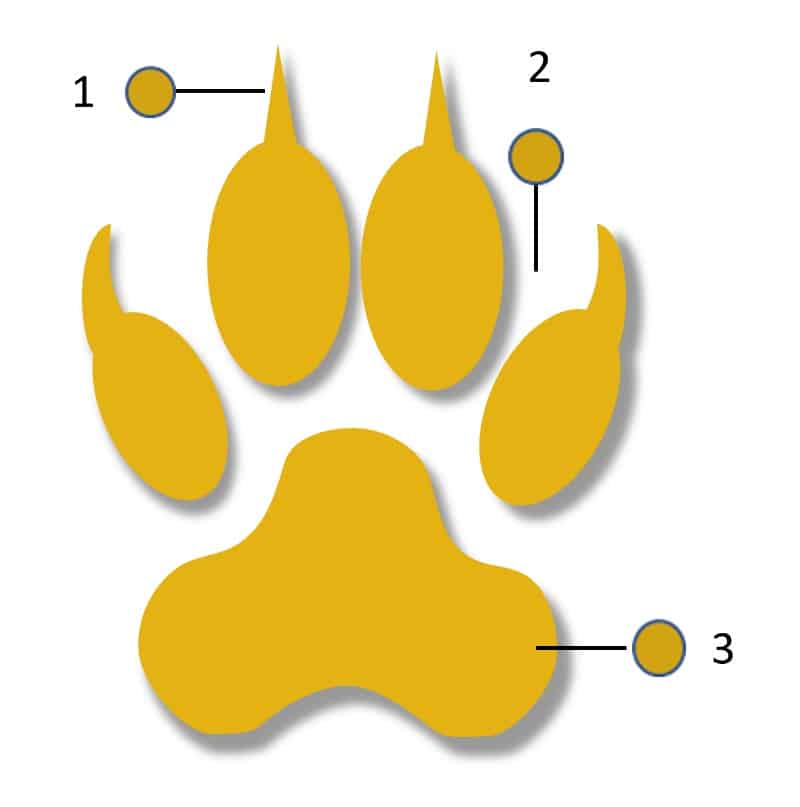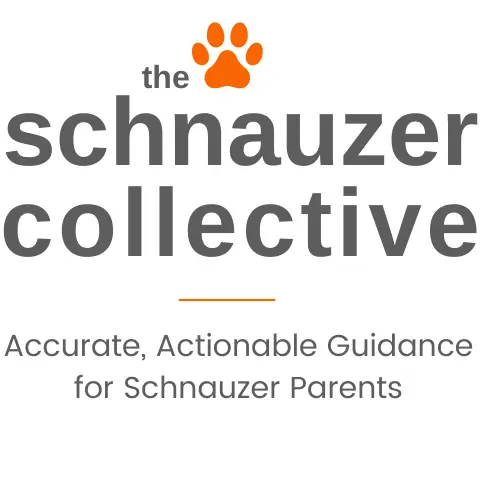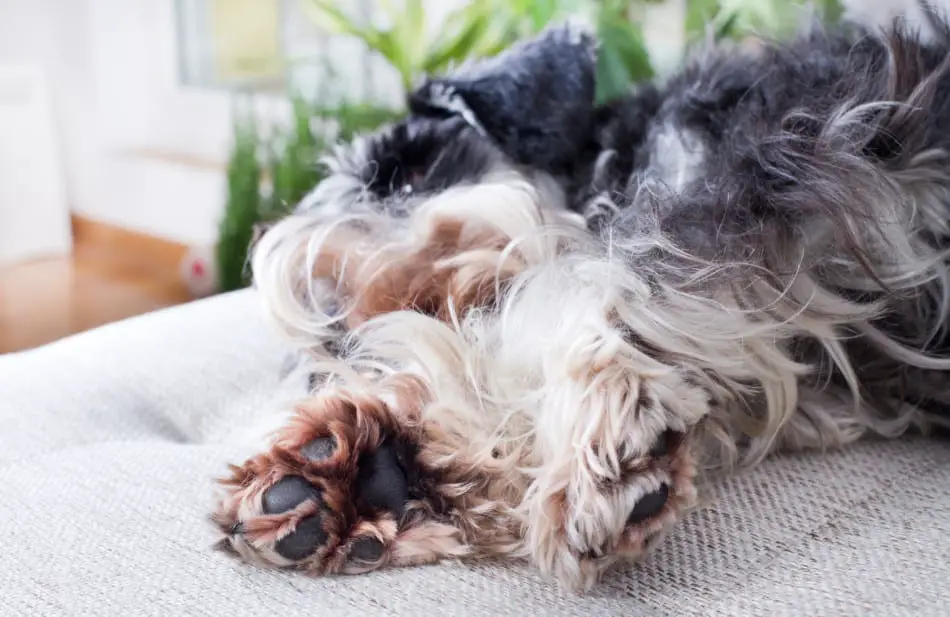Your Schnauzer’s mobility hinges on the health of his legs and paws. When you notice an injury, favoring, limping, or even excessive licking and biting, it’s time to understand what might be going on. Your Schnauzer’s paws are built for a lot of outdoor use, and they are pretty tough but they are not indestructable. Our Miniature Schnauzer, Livi, has gone through a few bouts of excessive licking, and after checking with her veterinarian, I made note of all of the possible reasons behind the behavior. Here’s the deal.
Why Do Schnauzers Lick and Bite Their Paws? Generally speaking, licking and biting paws is simply a grooming technique that nearly all Schnauzers will engage in. However, it can also be due to anxiety, health problems, a yeast infection, or even boredom.
Schnauzers can spend a great deal of time licking their paws. This behavior is natural for the most part, especially if your Schnauzer is a meticulous self-groomer. He is likely to lick his feet after meals, a walk, and when settling in his bed to sleep. Schnauzers that don’t self-groom often also lick their paws occasionally.
However, the behavior becomes a concern when the dog licks his paws incessantly, sometimes developing injuries.
If licking or biting becomes excessive, you can implement distraction or retraining techniques, and also schedule a visit with your veterinarian to rule out serious health issues.
Let’s talk about what is normal and what is not, along with strategies for minimizing any excessive licking and biting.
When is it Normal for Schnauzers to Lick and Bite Their Paws?
If your Schnauzer is licking his paws occasionally and upon inspection the paws look normal (there is no redness or swelling), then you have nothing to worry about.
Licking and biting at paws is a normal grooming technique that most, if not all, Schnauzers will engage it.
Many dogs, including Schnauzers, also lick paws before sleeping as a way of relaxing and soothing their bodies.
When Should I Worry About Paw Licking and Biting?
Licking and biting is a problem when the behavior is persistent and the paws develop pain, irritation, or inflammation. The dog’s paws may also develop redness, odor, bleeding, and wounds that can be difficult to treat.
For example, your Schnauzer may have stepped on something sharp or a hot pavement, causing pain. In addition, an insect bite or a foreign object stuck on his paw can irritate him.

Additional reasons that cause Schnauzers to lick and chew their paws include:
Allergies
Dogs are prone to seasonal allergies caused by mold, pollen, or cleaning products at home. Some dogs also develop reactions to specific foods like wheat, lamb, eggs, dairy, corn, chicken, or soy. Other causes of allergies include dust mites, prescription drugs, plastic or rubber material, insecticidal shampoo as well as flea-control and cleaning products.
It can be challenging to identify the ingredient causing the allergy unless your Schnauzer has had prior exposure to the ingredient. As such, you need to visit the vet to perform a food allergy test to determine the specific ingredient leading to the allergic reaction.
Gastrointestinal Problems
A clinical study was conducted to compare ten healthy dogs against 19 dogs that showed signs of excessive licking. A thorough physical, neurologic, and endoscopic examination was performed. The examinations revealed that 14 out of 19 dogs that were licking their paws excessively had GI abnormalities like gastric foreign body, lymphocytic-plasmacytic and chronic pancreatitis.
Anxiety
Dogs with anxiety syndrome find relief by licking their paws excessively. This condition is similar to humans’ nail-biting behavior when they are anxious. Some causes of anxiety include depression, lack of adequate exercise, illnesses, depression, and separation from the dog’s owner for an extended period.
You will want to read my article Is My Schnauzer Stressed? How to Tell and What to Do for helpful tips if Your Schnauzer seems to be anxious.
Boredom
Modern dogs barely engage in adventurous activities like hunting. Schnauzers are a particularly energetic breed because they have historically been hunters and watchdogs. It is this pent up energy that causes them to engage in destructive behavior, including excessive licking and biting of its paws.

Some ways to keep him engaged include:
- Avoid leaving your Schnauzer at home alone for prolonged periods
- Allow him to socialize with other dogs and people
- Keep him engaged if you must leave him alone
- Take him for a walk at least 30 minutes each day
- Engage him in a new sport or training. My article What are the Best Sports for Schnauzers will give you a great start.
Dry Skin
Dry skin can also cause a dog to lick and bite its paws. Dry skin can be breed-specific or a result of cold and dry weather. Schnauzers tend to have oily skin, but can also develop dry skin under certain conditions.
For example, if you are living in cold and dry climates, your Schnauzer may lick and bite his paws as a result of dry skin. In such a scenario, it is essential to ask a vet for a suitable dog oil or lotion to relieve dryness. Additionally, you need to avoid bathing using harsh soaps or excessive bathing as it can also cause your dog to develop dry skin.
Parasites
Mites, fleas, ticks also cause itchy sensations, and your Schnauzer may address the problem by compulsive paw licking. The condition becomes worse if your Schnauzer is already allergic to fleas. Be sure to visit your veterinarian to recommend appropriate medication and avoid administering over-the-counter drugs.
Cold Weather
If your Schnauzer only licks paws during winter, it may be as a result of sore paws caused by ice balls or deicing salts. Ice balls form between hairy toes when the snow gets stuck in the fur. This can lead to bleeding, cracking, and extremely painful hair pulling. As such, you need to keep the hair between the toes and pads short and trimmed during winter.
De-icing salts are used to melt ice on roads and driveways and can cause burns on a dog’s feet. It is essential to avoid walking on driveways that have been sprayed with de-icing products. And be sure your Schnauzer DOES NOT eat de-icing products since they can be poisonous to him.
In addition, consider putting a bowl of warm water near the door, so your Schnauzer can wash off his feet after a walk.
How to Inspect your Schnauzers Paws
It’s essential to check your Schnauzer’s paws often, especially after outdoor play or a long walk. Examine his feet for injury or damage. Keep his nails filed, and the hair around the paws trimmed using scissors. Avoid cutting too close to the skin as you may cut his paw accidentally.


- Inspect the nails for damage or cracks.
- Gently pull the toes apart and check for injuries or lodged objects.
- Inspect each pad and gently press on each one, being alert to pain, swelling, or bleeding.
How to Know if Your Schnauzer Has a Yeast Infection
Paw licking may also be a result of yeast infection. The condition is a result of an overgrowth of Malassezia species of yeast found in the ears, skin and mucocutaneous areas. Yeast infection is common in hot and humid climates. The infection occurs when the yeast is overproduced, overpopulating areas it normally resides.
This usually occurs when your dog’s immune system is weak. A dog’s body system has yeast just as humans, which feeds on sugars. The immune system and healthy flora keep the yeast in check. A dog’s diet should consist of meaty bones and meat, but most diets contain carbs which, when converted to sugars, cause yeast production to increase. Also, a high carb diet alters the pet’s PH.
It is this overgrowth and changes in PH that cause the dog to lick its paws compulsively.

The most apparent symptoms of a yeast infection include:
- Incessant itchiness
- Inflammation
- Sticky discharge, skin redness and sores (secondary signs)
- Skin irritation between the paws, ears, anal area, nasal folds, neck, and armpits
- Paws that smell like corn chips. You may want to read my article Why Does My Schnauzer Stink (And What to Do).
What to Do if Your Schnauzer is Licking or Biting Only One Paw
If your Schnauzer is licking only one paw, it is a sign of pain, irritation, or infection on that particular paw.
Pain in that area may be a result of insect bites, a broken nail, a thorn, a piece of embedded glass.
You need to examine the paw for any such signs and administer treatment by washing with benzoyl peroxide or pine-tar-based shampoo. Also, rubbing the area with an astringent like the witch hazel everyday goes a long way.
If the singular licking persists, or if your Schnauzer beings limping or favoring the paw, schedule a visit with your veterinarian.
What to Do if Paws are Raw and Bleeding Due to Licking or Biting
If your Schnauzer’s paw is raw or bleeding, you will want to administer some first aid before taking the him to the veterinarian.
If the dog’s paw is bleeding, apply pressure on the wound and clean its footpad. You can wrap the area with a bandage if it is bleeding excessively. Your veterinarian will most likely recommend medication to suppress the urge to lick and bite, especially if it is a result of a yeast infection.
The veterinarian will also require you to keep an eye on the dog’s paw and take note of any signs like swelling, smelly discharge, or foul smell. In addition, keep an eye on areas where your Schnauzer walks and play and remove pieces of metal, glass, and sharp objects as they can injure his paws.
How To Stop Your Schnauzer From Licking and Biting
If the problem is behavioral and not a result of health problems, then it may be because of boredom, fear, stress, or anxiety. In such scenarios, your Schnauzer started licking to get rid of boredom, and it later developed into a habit that has become very rewarding to him.
Some dogs may develop obsessive-compulsive tendencies, which are difficult to stop.
Distraction
The most effective way to address the problem, barring any health issues or deep-rooted anxiety, is to distract your Schnauzer.
Keep him busy by playing with him, going for walks and offering toys that keep him focused for a long time.
Re-Training and Behavior Modification
However, if the behavior is persistent, consider administering behavior modification techniques like habituation, conditioning, extinction among others. When employing these techniques, you need to avoid scolding the dog each time he licks. Schnauzers are particularly unresponsive to yelling and scolding. Also, avoid rewarding them with treats.
You also need to be patient and consistent with the techniques to bear the desired results. This is because your dog is already accustomed to certain behavior, and it takes time to help him learn a new one.
Enlist Professional Help
You may also enlist the help of an animal behaviorist, dog trainer, or animal specialist to help your Schnauzer learn the new behavior. Alternatively, apply a bitter-tasting topical product to discourage him from licking. If it is not effective, use a physical restraint like an e-collar.
While most paw licking and biting will remain within a normal range, staying alert to your Schnauzer’s excessive behavior can alert you to more serious problems. When it becomes clear that the licking and biting is not part of your Schnauzer’s normal grooming routine, consider the information above to get the behavior resolved.
And finally, from one pet parent to another, discover my all-time favorite resources designed to cover your every Schnauzer need. I’ve done the legwork for you so you can spend more time with the people and fur friends in your life.
A portion of all profit earned on this site is donated to Pet Partners
whose mission is to improve human health and
well-being through the human-animal bond.
They train and register pets to become therapy animals,
and have local chapters in many states.

